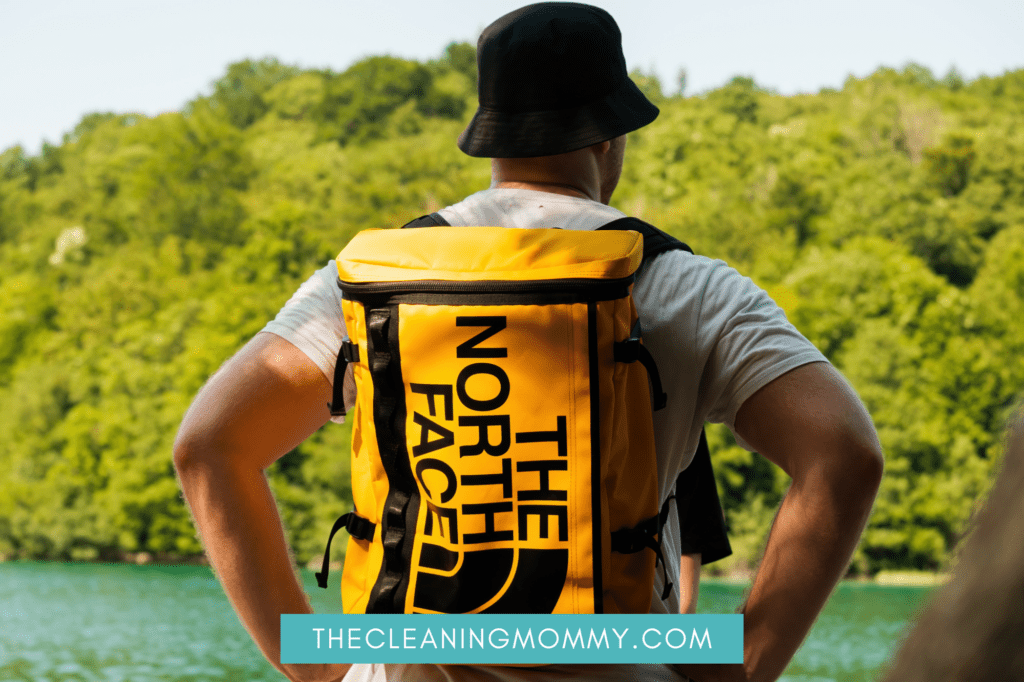If you’re the proud owner of a North Face backpack, then you know just how durable and versatile these backpacks can be. Whether you’re using it for school, traveling, or outdoor adventures, your North Face backpack likely sees a lot of wear and tear. One of the best ways to ensure the longevity of your backpack is to keep it clean. Today, I’m going to show you how to wash north face backpack the right way!
However, it’s important to take the proper precautions to ensure that you don’t damage the materials, zippers, or straps. From selecting the right products to knowing the proper cleaning process, we’ll guide you through everything you need to know to successfully clean your dirty North Face backpack. With the right care, your North Face backpack can last for many adventures to come.

Is It Safe To Wash North Face Backpacks?
When it comes to the cleaning and maintenance of your expensive backpack, it is important to keep in mind that regular washing can degrade weather protection and reduce its lifespan. However, there are times when cleaning is necessary to keep the bag hygienic and in good condition.
When it comes to cleaning camping equipment, especially after a long hike, it is essential to understand the importance of doing so. The dirt and debris that accumulate on your equipment during a hike can seriously damage it if not cleaned properly. For instance, hiking boots can develop cracks or lose their waterproofing capabilities if not cleaned and dried properly. Similarly, a pack can sustain damage if its straps and zippers are not thoroughly cleaned.
Moreover, cleaning your camping equipment is equally important for your hygiene as well. During a hike, sweat and dirt can easily stick to your gear and cause irritation and discomfort, especially when in contact with sensitive skin. Additionally, dirt and sweat can cause skin infections, rashes or other skin problems if not cleaned off properly.
When cleaning your camping equipment, it’s best to follow the manufacturer’s instructions. Use a soap or detergent and a soft-bristled brush to remove dirt and debris. Avoid using robust chemicals like bleach or abrasive materials as they can damage the fabric or material of your gear.
Cleaning your camping equipment after a hike is crucial to keep it in good condition and prolong its lifespan. Moreover, it’s important for your hygiene.

How to Wash North Face Backpack! (Step by Step)
Check the care instructions
To avoid damaging your backpack, you should start by reading the manufacturer’s instructions. This will give you a good idea of the materials used to construct the backpack, as well as the recommended washing method.
As a general rule of thumb, spot cleaning your North Face backpack whenever possible is best. This involves using a damp cloth or sponge to gently remove any dirt or stains without applying excessive force. For more stubborn stains, you can use a mild detergent with warm soapy water that is safe for the particular material of your backpack.
If you must wash your backpack fully, then it is important to avoid using harsh chemicals, hot water, or abrasive materials that could damage the fabric. Instead, hand-wash the backpack in cool or lukewarm water with a gentle detergent. Avoid using a washing machine or dryer, as the high heat and agitation can cause the backpack to lose its shape and structural integrity.
Once you have washed the backpack, it is important to let it air-dry completely before use. Avoid exposing it to direct sunlight or high heat, as this could cause further damage to the fabric and straps. A cool, dry, and ventilated area is best for drying your backpack.
In summary, while it is generally advised to limit the washing of your expensive backpack, there are times when cleaning is necessary. By following these guidelines and taking proper care of your backpack with spot cleaning, you can ensure to keep your North Face backpack clean.

Different Methods To Wash North Face Backpack
There are a variety of ways to wash North Face backpacks. Let’s dive into a few methods here before you begin cleaning that work with most North Face backpacks. Remember to always test inconspicuous areas first to ensure colors won’t fade or bleed during your cleaning method.
#1 Hand Washing
When it comes to caring for our favorite outdoor gear, hand washing can often be the most gentle option. But can you hand wash a North Face backpack? The answer is yes, but it requires some extra attention to detail.
Firstly, it’s important to check the care tag on your backpack to ensure it is safe to be hand washed. Most North Face backpacks are made from a combination of materials, such as polyester and nylon, that are durable enough to withstand hand washing.
Next, remove any loose dirt or debris by gently brushing the backpack with a soft-bristled brush or wiping it down with a damp cloth. This will help prevent the dirt from spreading further into the materials during the washing process. Don’t forget the backpack’s interior.
Fill a large sink or bathtub with tepid water (not cold water) and add a few drops of mild detergent that is suitable for synthetic materials. Avoid using robust chemicals or fabric softeners, as these can damage the backpack’s water-resistant coating.
Submerge the backpack in the soapy water and gently agitate it with your hands. Pay extra attention to any areas that are particularly dirty or stained. Be careful not to scrub too hard or use abrasive materials, as this can cause fraying or damage to the backpack’s fabric.
Once you’ve finished washing the backpack, rinse it thoroughly with clean water until all the detergent residue have been removed. Gently squeeze out any excess water and hang the backpack up to air dry in a well-ventilated area. Avoid using a dryer or direct sunlight, as this can cause the materials to warp or fade.

#2 Machine Washing
According to the manufacturer, washing the North Face backpack will damage its integrity. You can, however, use the gentle cycle with mild detergent and cool water only, and spin at a slow speed if you feel it is necessary.
Your backpack should not be dried in the dryer, but rather hung up to dry. To protect it even further from machine washing, you can put it inside a mesh laundry bag.
Step By Step Instructions For Washing Your Backpack
Spot cleaning your North Face backpack can help to maintain its quality and extend its lifespan. Follow these step-by-step instructions to effectively spot clean your backpack:
1. Empty your North Face backpack – Before you start spot cleaning, ensure that your backpack is completely empty. Remove all contents from your backpack and shake your backpack upside down to get rid of any loose dirt and debris.
2. Clean pockets and corners – Once your backpack is empty, use a cold wet sponge to wipe out all the pockets and corners of your entire backpack. This will help to get rid of any dirt, dust, or debris that may be lodged in these areas. Make sure to squeeze out excess water from the sponge before you use it. (A vacuum cleaner is great for getting inside those pockets!)
3. Use a toothbrush – If your backpack has zippers, they may have dirt or debris stuck in their teeth. Use a toothbrush or soft brush with mild soap to gently scrub away any dirt or debris that may be stuck in the zippers. Be gentle to avoid damaging the zippers.
4. Rinse the area – After cleaning with the warm wet sponge, rinse the area with a clean soft cloth. Make sure the to use at least a damp cloth, but not soaking wet. Rinse the North Face backpack thoroughly with cool water to make sure there is no residual soap or remaining dirt in your backpack.
5. Hang dry indoors or in the shade – Once you have spot cleaned your North Face backpack, allow it to dry completely. Hang the entire bag upside down in a well-ventilated area and avoid direct sunlight to prevent color fading.
Can You Machine Wash Your North Face Backpack?
North Face backpacks are known for their durability and long-lasting quality. However, after continuous and rigorous use, they may become dirty or stained, prompting a need for a machine wash. It is important to note that washing a North Face backpack should be done only when absolutely necessary (with the gentle cycle), as excessive washing may damage the material and cause wear and tear.
To begin the washing process, spot cleaning with a wet cloth is the first step. This is a gentle and effective method of removing dirt and stains from the surface of the backpack. Remember to use cold water and not hot, as hot water can cause the color to fade or bleed. If spot cleaning fails to remove the stains, soaking the backpack in cold water in a bathtub and scrubbing it with a toothbrush can be effective. It is important to use a mild detergent for stubborn stains, as chemicals can damage the material of the backpack.
For heavily soiled backpacks, machine washing it in the delicate cold cycle or gentle cycle of a washing machine is a viable option, provided it is done at your own risk. This is because the agitator in the washing machine can be too harsh on delicate materials, causing damage to the backpack. It is important to never put the backpack in a dryer, as the heat can cause shrinkage and deformation of the material.
To wash a North Face backpack requires careful attention to detail and a gentle approach for machine washing. It is important to use mild detergents and cold water, avoid using too much warm water or harsh chemicals, and either tumble dry if you must, or air dry the backpack after washing (hang dry is the best option). You can use again once completely dry.
With proper care, a North Face backpack can last for years and withstand various environmental conditions.

Cleaning A Moldy Backpack
Mildew growth is a common issue that arises when a North Face backpack has been exposed to damp environments on camping trips. To remove mold from the backpack, utilize a vinegar solution, a soaking method, and exposure to natural sunlight. This is a simple and natural way to eliminate mold, without having to use any chemicals, and keep your North Face backpack smelling fresh.
North Face backpacks can be cleaned with plain white vinegar. An ok backpack should have a little dirt on it, and this is the biggest reason to wash it. It is possible to have mold and mildew grow on backpacks if they are kept in a closet or near a damp wall.
Mold can be treated with vinegar because it is antifungal and antibacterial. Make a spray bottle of full strength vinegar and spray it on the infestation area. Allow it to sit for at least one hour( or, let it sit overnight) before cleaning away the mold with a damp cloth. You should try to hang your backpack outside to air dry in full sunlight if possible.

Using Baking Soda
You can also use sodium bicarbonate to wash a North Face pack or bag. Your bag should be unzipped, and everything inside it should be removed. You must ensure that it is completely empty. Flip the bag inside out, outside, or in a sunny location. You should leave your bag out for 24 hours to completely dry.
As soon as it has been 24 hours, return your bag to its original shape by bringing it back inside. The bag should be filled with 1/2 cup of baking soda. Adding another 1/2 cup if needed will ensure that it completely covers the bottom of your bag. Place the bag in a dark, dry place overnight. Zip it up and leave it there for the day (or at least a few hours).
Get a wet towel, paper towel, or wet cloth and open your bag in the morning or the next day.
Gently scrub the mold or mildew with the tool or washcloth while using baking soda as a scrubbing aid, with a little warm water.
The baking soda should be discarded once the moldy or mildewed area has disappeared. If you’re going machine washed, you should wash your bag on the wash cycle that is recommended for your washing machine. Use a laundry bag to protect against damage caused by the machine itself. Leaving it to hang dry will prevent mold and mildew.
Genius Cleaning Tips For North Face Backpacks
Need to wash a North Face bag? NikWax Tech Wash is a highly reliable cleaning solution that is specifically designed for backpacks. It is a popular choice among experienced backpackers who want to keep their packs in top condition for years to come. This powerful formula refreshes the backpack material’s water resistance capacity and breathability to keep you dry and comfortable.
One of the key benefits of using this product to wash a North Face bag, is that it is incredibly effective at lifting dirt and grime from the surface of your backpack. This is important because accumulated dirt and debris can compromise the water resistance of your backpack, leading to leaks and a less comfortable experience on the trail. By using NikWax Tech Wash, you can eliminate dirt and restore your backpack’s resistance to optimal levels.
Another advantage is that it does not contain any harmful chemicals that could damage your backpack. In fact, it is entirely eco-friendly and biodegradable, which means that it won’t harm the environment either. This makes it an ideal choice for environmentally-conscious backpackers who want to minimize their impact on the planet.
NikWax Tech Wash is especially beneficial for North Face backpacks, which are renowned for their durability and performance. These backpacks are designed to withstand the toughest conditions, but they still need regular maintenance to ensure that they continue to perform at their best. Using this product is a simple and effective way to keep your North Face backpack in top condition, no matter where your adventures take you.
NikWax is a trusted cleaning solution that is ideal for backpackers and anyone else who wants to keep their pack in great condition. Its powerful formula refreshes the backpack material’s water resistance capacity and breathability, while its eco-friendly and non-toxic formulation ensures that it is safe for both your backpack and the environment. If you want to ensure that your pack lasts for years to come, NikWax is the perfect solution for a clean backpack.

Applying DWR
To apply DWR (Durable Water Repellent) to a bag using a regular towel, you’ll need a few things. Firstly, make sure you have a clean towel that is free from any detergent or fabric softeners, as these can affect the effectiveness of the DWR. You’ll also need a bottle of DWR spray, which can be purchased at most outdoor or sporting goods stores.
To begin, start by laying the bag flat on a clean and dry surface. Next, apply the DWR evenly over the surface of the bag, making sure to cover all areas, including seams and zippers. It’s important to apply the spray in a well-ventilated area, as the fumes can be harmful if inhaled. Also, make sure to follow the directions on the bottle of DWR for optimal results.
Once the bag has been sprayed with the DWR, use a regular towel to wipe off any excess liquid, making sure that the bag is dry to the touch. The towel will also help to spread the DWR evenly across the bag’s surface, ensuring that it is fully coated.
After applying the DWR, it’s important to let the bag dry completely before using it in any wet weather conditions. This will allow the DWR to fully bond with the bag’s material and provide maximum protection against moisture.
In summary, applying DWR to a bag using a towel or clean cloth is a simple process that can be done at home with a few basic supplies. By following these steps, your bag will be better equipped to handle rainy or wet conditions, keeping your belongings safe and dry.
Other Cleaning Articles You May Enjoy:
- How to clean bath toys
- How to clean high chair straps
- How to get scentsy wax out of clothing
- How to get eyeliner out of carpet
- How to clean ghosting on walls

Grainne Foley
Grainne Foley is a wife and mother of 2 great kids. During her 5 years of full time RV travel, Grainne learned to become very efficient at household chores, in order to make time for family adventures. Now, back in a house, she has continued to create tools and techniques to help others lighten the load of household organization and cleaning.





Leave a Reply